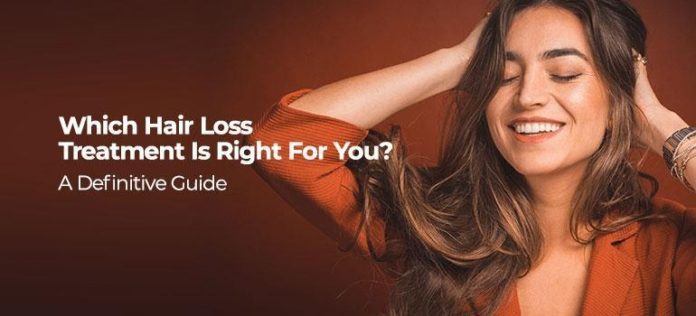While we all shed as many as 100 hairs every day without noticing, hair loss that results in visible thinning and bald patches is experienced by far more people than we realize. Male pattern baldness is perhaps the most obvious example of this and is experienced by as many as half of men over the age of 50. Alopecia, the medical term for hair loss, affects as much as 2% of the population, including an astounding 8 million women.
The prevalence of this condition, however, has led to several breakthrough treatments. To help guide you through which of these solutions is best suited to you, we’re going to consider the treatments available, and which stages of hair loss they are meant for, starting with light thinning, right up to extreme hair loss as a result of conditions like androgenic (also known as androgenetic) alopecia or male or female pattern baldness.
1) Hair Loss Prevention
Prevention is always the best cure, which is why preventative measures are a viable treatment for anyone at the start of their hair loss journey. It is important to note that conditions such as alopecia areata cannot be prevented, but steps can certainly be taken to offset male and female pattern baldness, and age-related hair thinning while it is developing. Prevention pointers especially worth noting if you begin to notice hair loss include:
- A change in diet: We are what we eat, and your food choices can have a pretty major impact on hair health overall. Foods high in proteins, antioxidants, and omega-3 fatty acids (e.g. salmon, sweet potatoes, beans, etc.) are especially beneficial for healthy hair growth. Contrarily, sugary foods high in saturated fats can lead to brittle, unhealthy hair that’s more likely to fall out.
- Scalp and hair care: Incorporating scalp health into your hair care routine, whether by investing in scalp-specific products, scalp massaging, or the like, can all help to prevent hair loss and even encourage hair regrowth with healthier follicles.
- Avoid chemicals and heat: Chemical treatments like perms, and heat-based styling methods such as straightening, can cause problems when used over extended periods. Limiting the chemicals and heat that you use on your hair can make a significant difference in preventing hair loss.
Further reading: Ways to prevent hair loss before it starts
2) Medications for Hair Loss Treatment
Over-the-counter hair loss medications are typically available in the form of topical ointments that can help to treat mild-to-worsening hair loss. The most commonly used options include:
Propecia
Propecia, which is more commonly branded as Finasteride for US markets, is an effective hair loss treatment for male pattern baldness. Ongoing use (e.g. 3+ months) of this treatment has especially had positive effects for as many as 90% of men, with an impressive 66% noticing hair regrowth. However, Propecia is only suitable for adult males and should absolutely be avoided by women who are pregnant or breastfeeding.
Minoxidil
Commonly used in combination with Propecia, Minoxidil, also known as Rogaine (North America) or Regaine (UK), can help to stimulate hair regrowth in cases of both male and female pattern baldness. Topical solutions should be applied directly to areas of hair loss, which has shown to prolong the growth period of hair.
3) Low-Level Laser Therapy
In cases where baldness and thinning are worsening due to conditions such as androgenic alopecia or ones where other treatments are unsuitable, laser hair therapy is an effective technology for hair regrowth. Available through a range of different approaches that can be used either with other treatments or as standalone solutions, laser hair therapy especially promotes a healthy head of hair through exposure to concentrated lights that stimulate growth. Available laser devices include:
Laser Hats
Laser hats, like the 272 PowerFlex laser cap, offer full scalp coverage for the treatment and reversing of generalized hair loss. Laser caps have been found to increase hair thickness and cover bald spots in both men and women when used consistently. Densely-spaced laser diodes are specifically used here to ensure even stimulation and have shown effective results for even patchy hair loss. For best results, the recommended treatment is 15-30 minute uses, three times a week.
Laser Bands
By comparison, laser bands like the 82 ComfortFlex that only require fast, 90-second treatment times, three times a week are an easier solution for individuals with more localized hair loss. AS the name suggests, laser bands are cordless, flexible bands that are placed on specific areas of the scalp and can be moved as needed to the front, middle, or back of the head.
Laser Combs
In cases of lighter or more localized hair loss, combs with laser-light-emitting diodes known as laser combs can be used for an average of around 8 minutes a day, three times a week. Options like the Ultima 9 LaserComb offer targeted and generalized scalp treatments with the benefits of a handheld, ergonomic design that makes hair loss treatment more convenient than ever.
4) Hair Loss Surgery
In cases of extreme hair loss, individuals may find that their best option is to seek hair transplant surgery. Most effective in cases of androgenetic alopecia, this treatment involves harvesting hair from the back of the head where they’re more resistant to hair loss, then surgically placing them where needed on the scalp. These hairs have been proven to grow successfully in as many as 85-95% of cases. However, given that this procedure is invasive—though minimally— alongside the risks of the scalp and follicles potentially rejecting the newly placed hairs, and the hefty price tag, surgery is a last resort for most people.
Start with The HairMax® Assessment
Wherever you are in your hair loss journey, seeking the right treatment is key in helping prevent escalating hair loss. HairMax®, a pioneer in the low-level laser light therapy (LLLT) treatments, carries a line of FDA-cleared products that have clinically shown great results in hair regrowth. Low-level laser therapy has proven to be an effective treatment regardless of a person’s stage of hair loss. The first step in reversing hair loss is knowing which treatment is best-suited to you. Get in touch with a member of our team today to learn more about LLLT first-hand or complete our online assessment to get started.
This article is originally from Hairmax. https://hairmax.com/blogs/news/which-hair-loss-treatment-is-right-for-you-a-definitive-guide
















